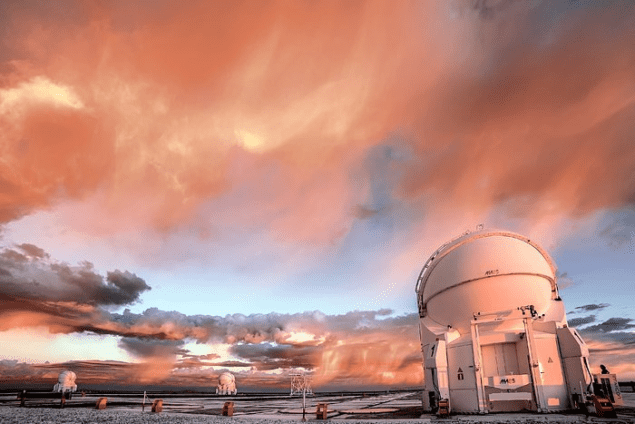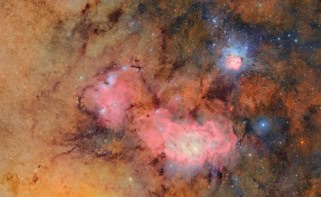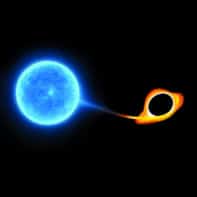
Rising global temperatures could worsen seasonal El Niño events and cause telescope images to lose their quality. That is the finding of an interdisciplinary team of researchers in Germany, who predict that climate-change-induced alterations in temperature, wind speed, humidity and “seeing” – atmospheric turbulence that causes blurring in images – will reduce the clarity of observations at ground-based telescopes around the world. The researchers, led by Faustine Cantalloube of the Max Planck Institute for Astronomy, argue that climate change therefore needs to be taken into account when building new observatories such as the Extremely Large Telescope (ELT), which is currently under construction at Cerro Armazones in Chile’s Atacama desert.
In their study, the researchers focused on the European Southern Observatory’s facility at Cerro Paranal, which is about 20 km from Cerro Armazones. There are three critical parameters for operating astronomical instruments: integrated water vapour (IWV), relative humidity and cloud coverage. They found that high IWV levels at Paranal, which affect astronomical observations in the infrared, were associated with high central equatorial sea surface temperatures during El Niño events. Although such events are a natural, periodic phenomenon, increases in atmospheric CO2 concentration could make them more vicious, thanks to the associated global rise in humidity. A rise in humidity could also cause previously rare catastrophes such as the March 2015 flooding of the Atacama region to become more frequent.
Atmospheric turbulence affecting images
The study also examined the direct effects of increasing temperatures on the four telescopes that make up Paranal’s Very Large Telescope (VLT) array. The dome enclosures that house these telescopes are kept cool during the day so that when the dome opens at sunset, the telescopes are at a similar temperature to the outside air. This cooling is necessary because any temperature difference between the inside of the dome, where the telescopes are found, and its environment can cause air turbulence. The air turbulence distorts the starlight that reaches the telescopes, much like how stars appear to twinkle to the naked eye thanks to turbulence in the higher atmosphere.
The VLT’s current thermal active control system, however, cannot exceed target temperatures of over 16 °C. Since the build-up of atmospheric CO2 is already linked to an increase of 1.5 °C in average temperatures at Paranal to over the past 40 years – 0.5 °C more than the global average – additional local increases in surface temperature could further impair observations.
The researchers used worst-case climate change scenarios on models such as the Coupled Model Intercomparison Project Phase 6 (CMIP6) multi-model ensemble to determine climate projections for the region. The results suggest that by the end of the 21st century, Paranal could experience a further 4 °C increase in average temperatures. This would cause a greater difference between the temperatures inside and outside of telescope domes, and generate more air turbulence.
Adaptive optics can help correct for atmospheric turbulence. However, the time lag associated with these corrections creates an imaging artefact known as a wind-driven halo. Such halos are caused by winds from the southern subtropical jet stream, they are visible in ~30-40% of images, and they dramatically reduce the image’s contrast. Many wind-driven halos occur during El Niño events, which are likely to become more frequent as well as more intense as global temperatures rise.
Mitigating the impact of climate change on research
On a global level, Cantalloube notes that increased humidity and worse seeing are far from the most pressing threats to astronomy. “Fires in the US and in Australia already destroyed or were about to destroy observatories,” she explains. “This is the most imminent threat that is a consequence of climate change.” Cantalloube adds that hurricanes in Hawaii, which have become stronger in recent years “could also threaten the Hawaiian-based observatories.” As for Chilean observatories, she says, “the effects are there”.
Disaster-proof astronomy?
According to Cantalloube, interdisciplinary teams like hers will become more prevalent over time as scientists seek to understand the many ways that climate change could impact research capabilities. She notes that her team’s paper, which appears in Nature Astronomy, is a preliminary study, focusing solely on the effects of climate change on observations conducted in Chile. Since climate change will likely affect different regions of the globe in different ways, the team hopes to extend its analysis to cover additional sites. In the meantime, Cantalloube urges members of the astronomy community to “investigate whether climate change and/or environmental signals are also detectable in the observations of other observatories/others fields of research” and “convince political leaders to act now against climate change”.



